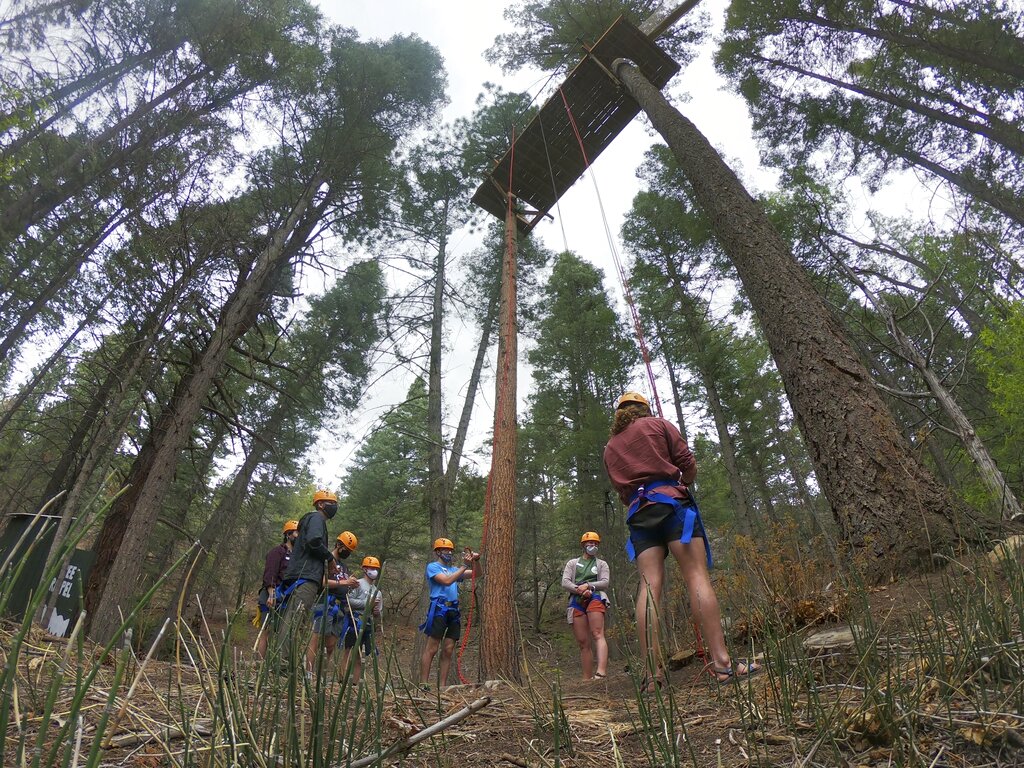
Cedar Attanasio/AP
Ahead of campers’ arrival in June, counselors at the Glorieta Adventure Camp train in tree rappelling on Friday, May 21, 2021, in Glorieta, N.M. The 3,000-bed camp outside Santa Fe opened up at a third of its normal capacity under pandemic restrictions after being closed last year. Campers and staff will be kept in pods of 10 or less, wear masks outside their sleeping quarters, and eat outdoors to prevent outbreaks.
Kennesaw, GA — Tina Lewis is helping her 10-year-old son Aaron get prepared for a week-long adventure at Camp Woodruff, a Boy Scout camp in the North Georgia mountains.
It will be his first time away from home for an extended period of time.
Lewis, an epidemiologist, said she has “no hesitation” about sending her boy to camp, even though he’s too young to receive the vaccine.
“There is definitely a safe way we can get kids back to being kids and hopefully return their mental health to a healthy state,” Lewis said. “I think camps, and that little bit of normalcy, will go far to help kids feel more secure.”
Lewis isn’t the only parent eager to send her child off to camp.
For more on related programs, research and resources, go to
► Youth Today’s OST Hub | Summer Learning
Ryan O’Malley of the YMCA, which operates about 230 overnight camps and about 10,000 day camps across the country, said most of the organization’s overnight camps are booking at 80 to 100% capacity.
“The demand is high, the enthusiasm is great, and we know, after a year of social distancing and online learning, how important this summer is going to be,” O’Malley said.
The YMCA has been working with epidemiologists, the Centers for Disease Control and Prevention, infectious disease specialists, and hygiene experts to create safety protocols.
O’Malley said the main takeaway from all the collective research is that putting campers into cohorts and masking were some of the most effective strategies in keeping them safe.
“The kids are so used to wearing masks now, that having to wear them at camp is not an extra strain,” he said. “As long as they can go play, they’re happy to do whatever is necessary to do that.”
When the CDC issued updated guidelines for summer camps at the end of May, the agency emphasized “how important camp can be for children’s social, emotional, and physical development.”
CDC Spokeswoman Jasmine Reed recommended camps use “multiple, layered prevention strategies to reduce the spread of COVID and protect people who are not fully vaccinated.”
These strategies include, but are not limited to: Promoting vaccination for eligible staff, campers, and their family members; wearing a mask in crowded outdoor settings; physical distancing; and “cohorting,” or managing kids in small groups that stick together.
Like any good Boy Scout, Aaron, 10, is going to camp prepared: In addition to packing a water bottle, extra socks and his trusty compass, he will also be bringing a supply of face masks.
Aaron didn’t seem too concerned about COVID-19, or the prospect of being away from home and gathering with other kids after a year of irregular socialization. He was more worried about what else he might encounter in the woods.
“I have a phobia of spiders,” he said. “I don’t want to get bitten by a spider or snake.”





























